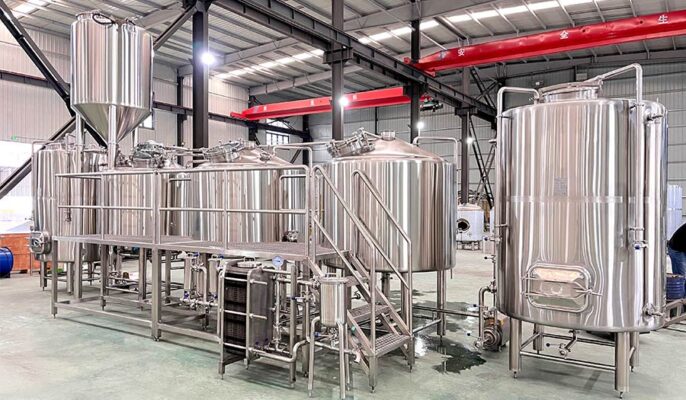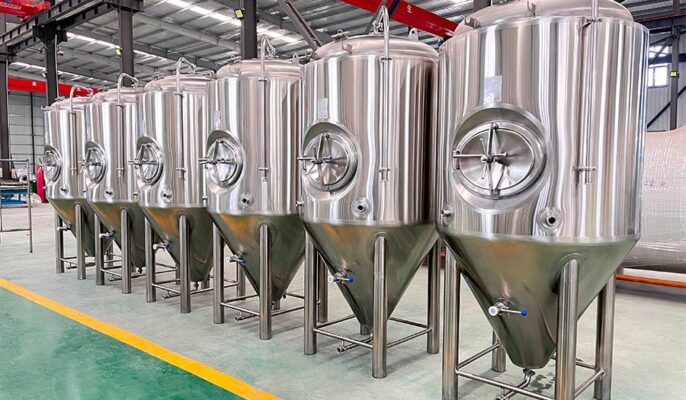Založení pivovaru může být splněním snu milovníka piva nebo sládka, který může být náročný. Náklady na založení pivovaru závisí na řadě faktorů, mezi něž patří například umístění, velikost, vybavení, suroviny, lidské zdroje a marketingová strategie. Proto je před založením pivovaru nutné vypracovat podrobný podnikatelský plán a rozpočet, abyste mohli přesně odhadnout svou investici. V této příručce vám inženýři společnosti Micet podrobně vysvětlí, jaké náklady jsou spojeny se založením úspěšného pivovaru.
Jaký typ pivovaru si vyberete pro založení?
Ne všechny pivovary jsou stejné a náklady na pivovarské vybavení se mohou značně lišit v závislosti na několika faktorech, jako je velikost pivovaru, typ pivovarského systému a konkrétní potřebné komponenty.
- Nanopivovary: Nanopivovary jsou menší, obvykle vyrábějí méně než 1000 sudů ročně. Tyto systémy jsou oblíbenou volbou pro začínající pivovary nebo pivotéky díky nižším počátečním nákladům.
- Minipivovary: Menší pivovary obvykle produkují 1 000 až 15 000 sudů piva ročně. Tyto systémy jsou oblíbené mezi malými a středně velkými nezávislými pivovary, které distribuují své výrobky regionálně.
- Regionální pivovary: Regionální pivovary vyrábějí větší objemy piva, obvykle 15 000 až 500 000 sudů ročně. Tyto systémy jsou složitější a vyžadují větší investice.
- Velké pivovary: Velké pivovary vyrábějí velké objemy piva, obvykle více než 500 000 sudů ročně. Náklady na tyto systémy se mohou pohybovat v milionech dolarů v závislosti na velikosti, technologii a automatizaci.

Počáteční náklady na pivovar
- Prostorová poloha: Umístění pivovaru je zásadním faktorem pro počáteční náklady. Náklady spojené s umístěním se mohou značně lišit v závislosti na tom, zda si prostory pronajmete, pronajmete nebo koupíte. Další náklady vznikají, pokud si místo vlastních prací najmete dekoratéra nebo instalatéra.
- Vybavení a inventář: I tak jsou ale výdaje za nové a vhodné vybavení (včetně kvasných nádob a sudů) dlouhodobým závazkem. Zatímco pivovary musí mít zásoby obilí, chmele a kvasnic, bary musí mít také zásoby piva, vína a lihovin.
- licence a povolení: k výrobě a prodeji alkoholických nápojů jsou zapotřebí licence a povolení. Poplatky se v jednotlivých státech a městech liší, počáteční vydání licence však obvykle není dobrovolné. Pokud potřebujete podporu právního odborníka, můžete platit stovky dolarů za hodinu.
- nábor a školení zaměstnanců: Počáteční nábor zaměstnanců může být dražší, než si myslíte. Nábor vysoce kvalifikovaných manažerů a sládků může vyžadovat použití drahých online platforem nebo najmutí drahých náborářů. Vyhlašování a vedení náborových kampaní může být nákladné.
Pivovarské vybavení Náklady na založení pivovaru
Vybavení pivovaru je rozhodujícím krokem při určování nákladů na zahájení provozu. Zde je seznam nezbytného vybavení pivovaru spolu s odhadovanými náklady:
- Varné konvice: Jejich cena se může pohybovat od $20 000 za malou jednotku až po více než $100 000 za větší a složitější systém.
- Kvasné nádoby: Cena fermentorů se liší v závislosti na velikosti a materiálu. Rozpočet na každý fermentor se pohybuje mezi $2 000 a $10 000.
- Frézovací zařízení: Mlýny používané k mletí obilí mohou stát od $1 000 do $5 000.
- Chladicí systémy: Chlazení je pro proces vaření velmi důležité a jeho cena se může pohybovat od $5 000 za základní systém až po $20 000 za větší systém.
- Balicí zařízení: V závislosti na způsobu balení (lahve, plechovky nebo sudy) se náklady mohou značně lišit. Například stáčecí linka může stát od $20 000 do $100 000.
- Nástroje pro kontrolu kvality: Pro udržení kvality piva potřebujete laboratorní vybavení, které může stát od několika tisíc dolarů až po více, v závislosti na složitosti vybavení.
- Skladovací nádrže: Pro skladování surovin a hotového piva potřebujete skladovací nádrže, které mohou stát přibližně $5 000 až $15 000 za kus.
- Čerpadla, potrubí a ventily: Ty jsou nezbytné pro pohyb kapalin v pivovaru a mohou stát tisíce dolarů.
- Čisticí zařízení: Investice do čisticího zařízení se může pohybovat od $2 000 do $10 000.
- Řídicí systémy pivovarů: Automatizace a řídicí systémy mohou vyžadovat značné investice, které se pohybují od $10 000 do $50 000 a více.
Faktory ovlivňující náklady pivovaru
Materiály pro vybavení pivovaru
- Měděné pivovarské zařízení: Měděné pivovarské vybavení se díky svým vlastnostem používá k vaření piva již stovky let. Dokáže rychle a rovnoměrně přenášet teplo do hrnce, čímž se mladina vaří. Tradičně začali lidé vařit pivo s měděným nádobím, protože měděné nádobí je velmi vhodné pro vaření mladiny při vysokých teplotách.
- Varné zařízení z nerezové oceli: Všechny velké komerční pivovary používají v moderní době varné zařízení z nerezové oceli. Ačkoli tam používané kotle nejsou kompletně vyrobeny z nerezové oceli, materiál z nerezové oceli nereaguje s chemikáliemi, ale reaguje s chlorem, takže správná dezinfekce neovlivní kvalitu piva vařeného pivovarským zařízením z nerezové oceli. Nerezová ocel je pevnější než měď, takže mladina nebude při varu za vysokých teplot namáhána.
Nové nebo použité pivovarské vybavení
Výrobní náklady na zařízení pro výrobu piva závisí také na tom, zda si pro svůj start koupíte nové zařízení nebo zařízení pro výrobu piva z druhé ruky. Nové zařízení bude samozřejmě dražší než zařízení z druhé ruky, ale pokud je vaše komerční pivovarské zařízení z druhé ruky v dobrém stavu, nebude to mít na vaření piva žádný vliv, před jeho nákupem si nezapomeňte zařízení pečlivě zkontrolovat. Nové pivovarské vybavení můžete zakoupit s jistotou, aniž byste se museli obávat dalších problémů, a také jej můžete používat delší dobu.
Funkce pivovarského zařízení
Funkce, které chcete od svého pivovarského zařízení, závisí na vašich požadavcích na proces vaření a produkty. Pokud váš produkt musí kvasit při nízkých teplotách, můžete potřebovat fermentor který dokáže přesně regulovat teplotu. Pokud pivo, které vaříte, vyžaduje vícestupňový proces rmutování a kvašení při nízkých teplotách, můžete potřebovat rmutovací systém s pokročilou regulací teploty. Pokud například chcete automatizované zařízení pro vaření piva, které vám ušetří čas a práci, může to znamenat, že náklady budou o něco vyšší.

Návrh zařízení pivovaru
Design zařízení ovlivní nejen jeho provoz a údržbu, ale také vizuální vzhled vašeho pivovaru. Můžete například chtít, aby zařízení mělo uživatelsky přívětivý ovládací panel pro snadné ovládání. Můžete také chtít, aby zařízení mělo jedinečný vzhled, který upoutá pozornost vašich zákazníků. Pokud například chcete, aby se zařízení snadno ovládalo, můžete chtít, aby mělo ovládací panel s jasnými popisky a intuitivním ovládáním. Ovládací panel by měl zobrazovat všechny důležité informace, jako je teplota, tlak a průtok, a měl by umožňovat snadnou úpravu nastavení. Pokud chcete, aby váš pivovar vynikal, můžete chtít, aby zařízení mělo jedinečný design. Může to být elegantní moderní design s čistými liniemi a leštěnými povrchy nebo rustikální tradiční design s měděnými ozdobami a dřevěnými detaily.
Dodavatel pivovarského zařízení
Výběr spolehlivého dodavatele pivovarského vybavení je klíčem k přizpůsobení vašeho vybavení. Dobrý dodavatel vám může poskytnout nejen vysoce kvalitní vybavení, ale také profesionální služby přizpůsobení, které vám pomohou navrhnout a vyrobit vybavení, které splňuje vaše potřeby. Při výběru dodavatele je třeba zvážit jeho zkušenosti, technické možnosti, kvalitu služeb a další faktory. Například společnost Micet Group je vyspělý tým se silnou technologií. Dokáže splnit vaše potřeby v oblasti přizpůsobení v každém ohledu.
ČASTO KLADENÉ DOTAZY
Kolik obvykle stojí zřízení minipivovaru?
Náklady na vybudování minipivovaru se značně liší a pohybují se od $1 000 za malé domácí pivovarské zařízení až po více než $80 000 za komerční pivovar v závislosti na různých faktorech, jako je velikost, vybavení a umístění.
Jaké další náklady jsou spojeny se založením minipivovaru?
Kromě nákladů na vybavení by majitelé minipivovarů měli vzít v úvahu poplatky za dopravu, zvedání a instalaci a další výdaje mohou zahrnovat povolení, stavební práce a suroviny.
Jak dlouho trvá, než se pivovar stane rentabilním?
Doba, za kterou se pivovar dostane na hranici rentability, se může značně lišit v závislosti na faktorech, jako je umístění, velikost a marketingová strategie. V průměru může trvat 2 až 5 let, než se pivovar stane ziskovým, ale tato doba může být kratší nebo delší v závislosti na konkrétní situaci.
Jaké udržitelné postupy bych měl zvážit pro svůj pivovar?
Vzhledem k tomu, že se udržitelnost stává v pivovarském průmyslu stále větší prioritou, je důležité zavádět ekologické postupy, jako je úspora vody, snižování množství odpadu a zvyšování energetické účinnosti. Tato opatření nejen pomáhají minimalizovat dopad na životní prostředí, ale také přitahují ekologicky uvědomělé spotřebitele a zároveň snižují provozní náklady.




